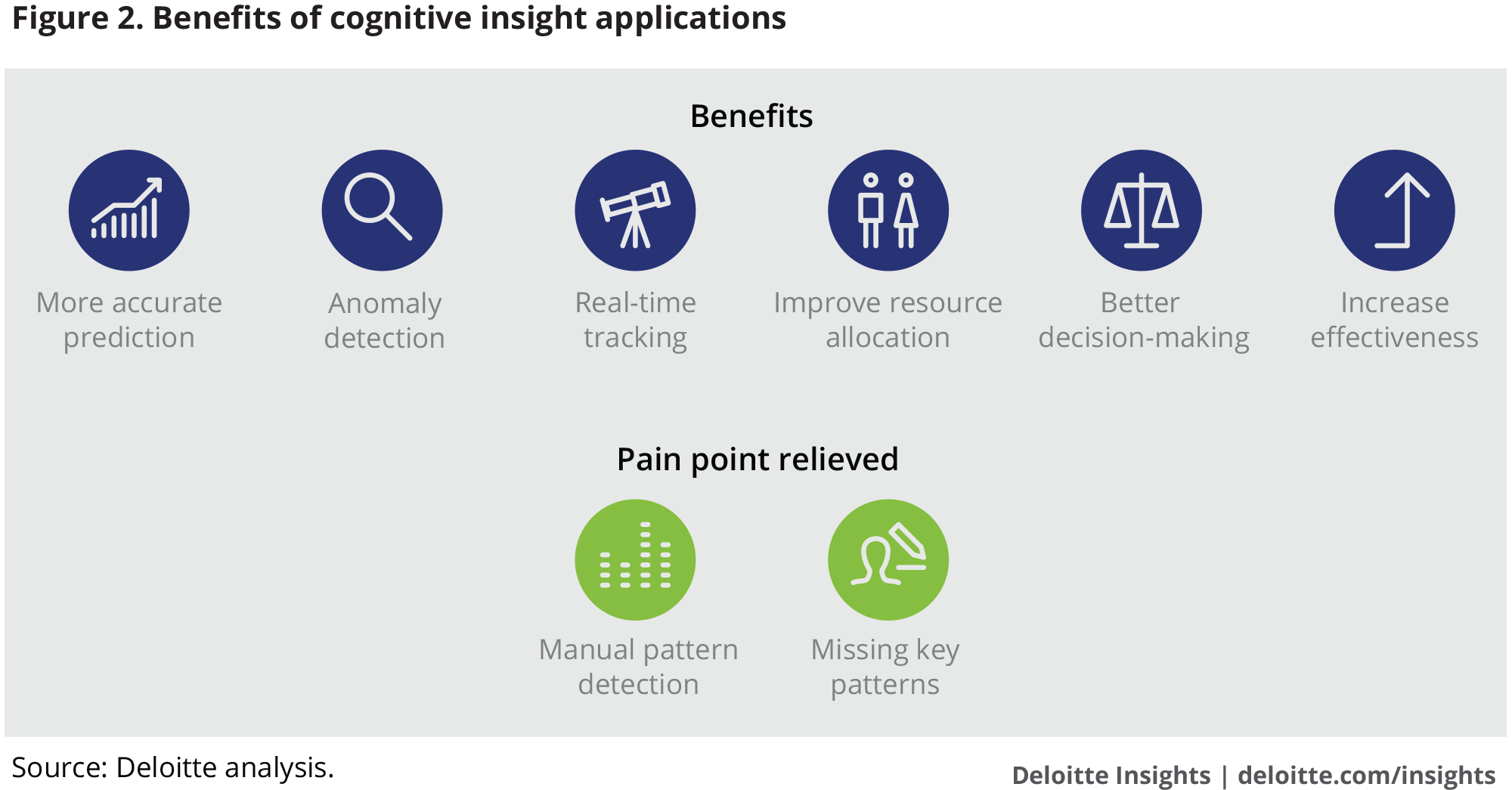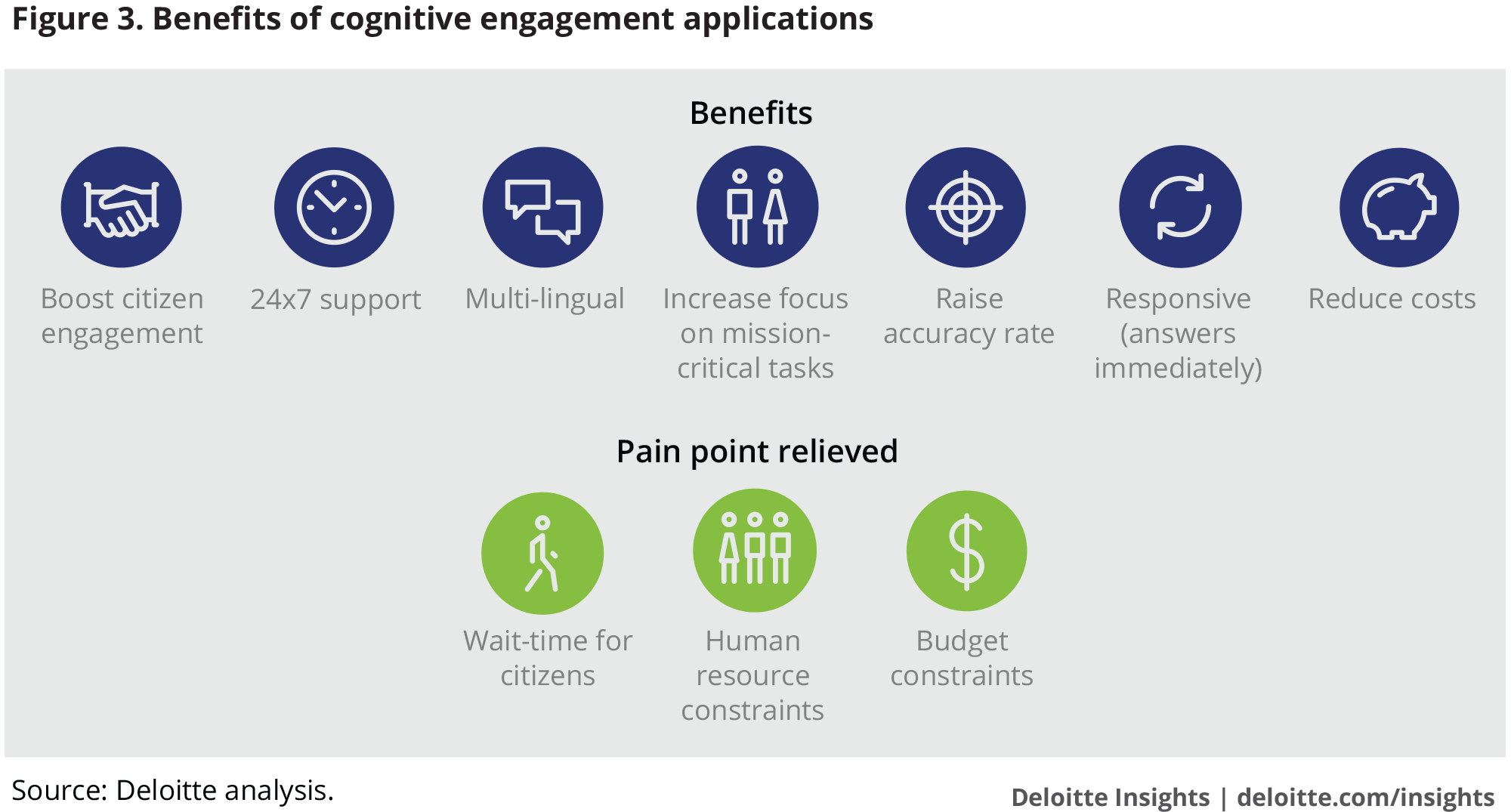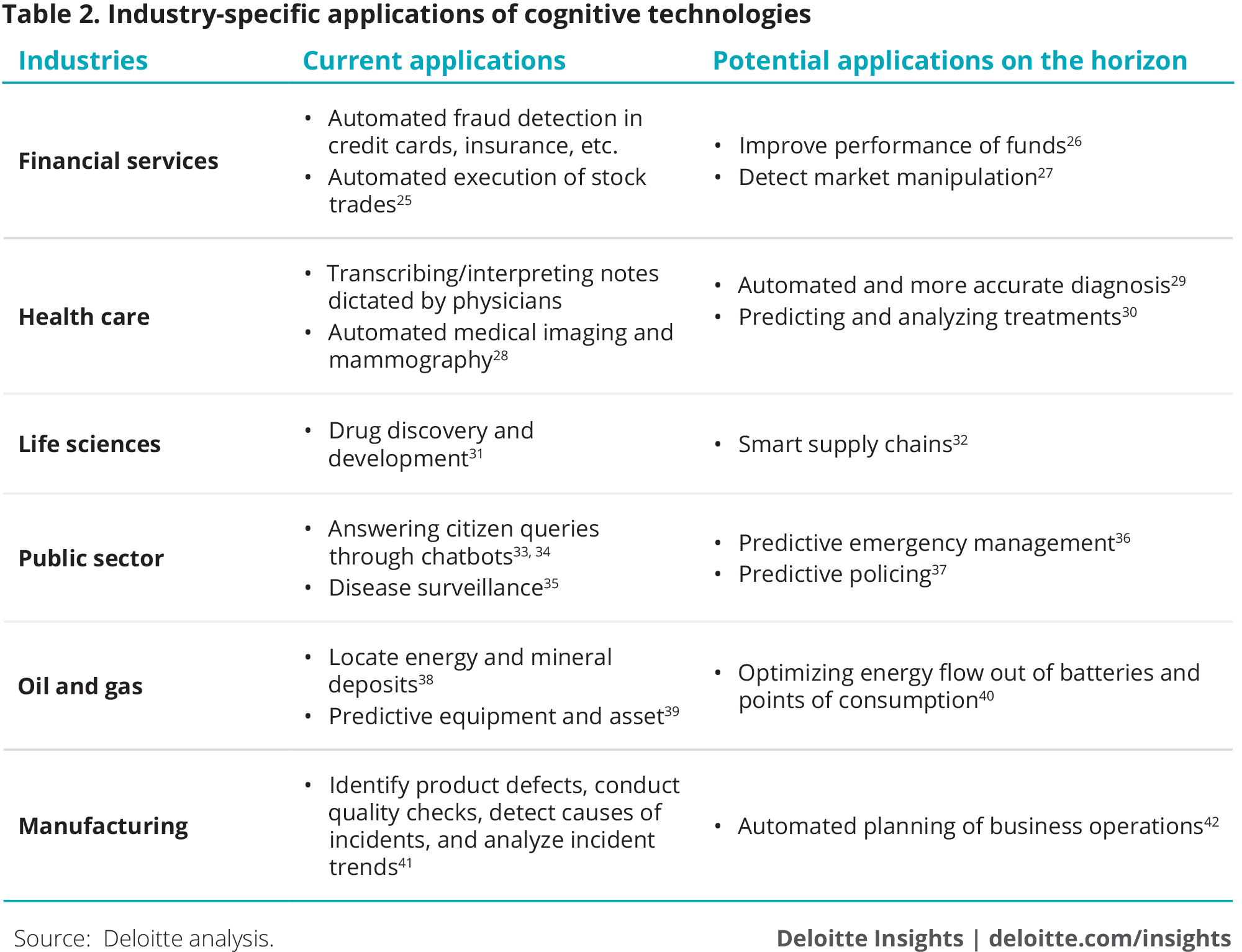Cognitive technologies has been saved

Cognitive technologies A technical primer
06 February 2018
Cognitive technologies offer advantages that are real and diverse, extending well beyond traditional applications like process automation. As the cognitive story evolves in the years ahead, the benefits that ensue may become ever richer in their variability.
Introduction
Learn more
Subscribe to receive updates on Emerging technologies
Cognitive technologies are now impacting almost every aspect of people’s lives. Not only are these technologies an emerging source of competitive advantage for businesses and the economy, but they also have the potential to improve societal well-being.1 They can be a disruptive force in the way work gets done and employers interact with workers, customers, and suppliers, as well as the trade-offs that conventionally govern the relationship between speed, cost, and quality.
This primer aims to help readers understand these technologies and the emerging landscape better, illustrate their transformational potential, and demonstrate how business and government leaders can adopt them in driving smarter insights and stronger organizational outcomes.
First, let’s get the basics right
There is no single definition of cognitive technologies. This primer, however, will define cognitive technologies as those technologies that can “perform and/or augment tasks, help better inform decisions, and accomplish objectives that have traditionally required human intelligence, such as planning, reasoning from partial or uncertain information, and learning.”2 This primer treats the terms cognitive technologies and artificial intelligence (AI) as interchangeable.
Currently four major categories of cognitive technologies seem to be expanding exponentially (table 1).

What drove the progress in cognitive technologies?
Since its first use in the 1950s, the field has been marked by periods of high expectations alternating with setbacks. However, since the beginning of the 21st century, some cognitive technologies have progressed significantly. Four key factors appear to be driving this:5
- Moore’s Law: The exponential growth in computing power at a given price has facilitated advances in computer systems that may not have been practical a few years ago.
- Big data: The rapid increase in the volume of data available has been a boon for some cognitive technologies. AI techniques that use statistical models to determine probabilities related to data can now improve their performance by training on large data sets.
- The Internet and the cloud: The rise of the Internet and cloud computing technology has enabled humans to collaborate with each other to train AI systems.6
- New algorithms for machine learning: Increasingly sophisticated algorithms have improved the performance of machine learning (which is the underlying technology for many other cognitive technologies such as computer vision) by improving the accuracy of data pattern identification and predictions. Many of these algorithms are available on an open-source basis.
Riding the cognitive technology wave: Guidelines for organizations
Despite the benefits that cognitive technologies offer, the decision to become a cognitive organization should be well-considered and grounded in reasonable expectations. While there are no hard and fast rules, some high-level guidelines can be of help to stakeholders as they consider their cognitive plans:
- Understand each cognitive technology—what it does well and how it is limited
- Leverage the current organizational strengths in big data and analytics; form internal teams dedicated to cognitive applications
- Create a portfolio of value opportunities matched to processes and tasks after evaluating data bottlenecks, scaling challenges, and computing power
- Create pilots or proofs of concept for projects with potentially high business value
- Recognize that the more ambitious the project and the more unproven the technology, the greater the likelihood of failure (as is true of other technologies)
- Perhaps, most importantly, consider the full range of benefits that cognitive technologies may provide. Cognitive technologies are not just about cost-cutting automation applications; they are as much, if not more, about smarter, better predictive insights.
Where is the cognitive world heading?
Industries are deploying cognitive technologies in their products, processes, and services. Between 2017 and 2021, global spending on AI-focused systems—including AI-focused hardware, software, and services—is expected to grow at a CAGR of 50 percent—reflecting some $200 billion in cumulative spending across an array of sectors including health care, retail, banking, and manufacturing.7 Top use cases are expected to be in object identification, image classification, and data processing.8 Beyond the projected $200 billion in cumulative direct spending on AI-specific hardware, software, and services are the larger economic benefits made possible by cognitive technology deployments. We will discuss these later in this primer.
Broadly speaking, three types of players operate in cognitive technology:9
Platform companies provide the virtual cloud environment in which reams of user data are stored and analyzed and from which insights are drawn. Leading players in this space typically include large search engine and online retail entities.
Application companies provide the AI applications or programming to optimize the user data in the cloud environment to achieve some end objective. Common AI applications include process optimization, image recognition, and predictive maintenance.
Capabilities companies are the players that actually work with the data housed on the AI platforms to drive actionable insights.
Brace yourself for hurdles when you begin
Despite the hype, most organizations are at a nascent stage in adopting cognitive technologies in their processes and offerings. Even among organizations within the same industry, adoption levels vary.10 Some factors that could explain the disparity between expectations and adoption levels include:
- Challenges in integration: One hurdle to adoption is integrating cognitive technology with existing systems.11 Respondents to Deloitte’s 2017 survey on cognitive technologies identify integration with existing systems and workflows as the single biggest hurdle that companies face in adopting cognitive technologies.12 Considering that cognitive technologies perform individual tasks and not complete processes, organizations should consider the feasibility of integrating them with existing systems.13
- Lack of understanding of cognitive technologies: In Deloitte’s survey on cognitive technologies, 40 percent of respondents cited a lack of understanding about how to use cognitive technologies to meet business needs as a key challenge.14 On the contrary, most organizations that are successful in adopting cognitive systems have a good understanding of these technologies, including what can be accomplished, the data required for training the algorithms, and the training processes involved, among other factors.
- Shortage of technical talent: Another barrier that many organizations continue to struggle with according to Deloitte’s survey is the lack of talent with technical skills and experience.15 Organizations that lack the required in-house talent can rope in external cognitive service providers for short-term needs. For long-term needs, training employees on the required skill set can help in developing a pool of technical experts.
- Change management challenges: Almost invariably, technology transformations are accompanied by a flurry of change management challenges, since most require work redesign. Adoption of automated systems can often lead to lower employee morale and reduced satisfaction and productivity, which in turn could alienate the workforce. Workers may need to acquire new skills. Thus, it’s important to roll out upskilling programs to promote continuous improvement and for learning needs to become “business-as-usual” for organizations.16 Many respondents to the 2017 survey say they are already offering such programs.
Other commonly cited challenges in adopting cognitive technologies include their cost and state of “maturity” to drive competitive advantage.17
What’s possible with cognitive technologies today?
Despite challenges, many organizations across industries are using cognitive technologies to relieve various business pain points and realize the benefits that they bring. Based on how cognitive technologies can support business needs, we tend to organize them under three broad categories:
Robotics and cognitive automation: Essentially the coupling of RPA and data science, robotics and cognitive automation involves the automation of repetitive manual tasks and workflows by allowing machines or RPA bots to replicate human actions and judgments (figure 1). Well suited for time-consuming, routine, and information-intensive tasks such as invoice processing and claims settlement, process automation is the least expensive of automation technologies and the easiest to implement. It often results in headcount reduction and accompanying bottom-line cost savings. Process automation also allows organizations to reap significant productivity gains relatively easily “without undergoing a major process redesign,” as well as greater process consistency and quality.18 Besides, this approach can free up employees to focus on higher-value work that entails uniquely human capabilities such as empathy or emotions.19

Process automation used with cognitive technologies would make it possible to achieve previously unachievable speed, scale, and volume. Take, for example, e-discovery (electronic document discovery) used in the discovery phase of legal cases, which allows lawyers to sift through large document dumps to locate relevant cases. E-discovery can locate 95 percent of the relevant documents against humans’ 50 percent, in a fraction of the time.20
Cognitive insights: Cognitive technologies such as machine learning (ML) and natural language processing (NLP) can find complex patterns in data that are not easily identifiable by humans and help organizations make better decisions and more accurate predictions (figure 2). For example, organizations can predict consumer purchases, recognize fraudulent credit card activity, automate personalized targeting of digital ads, and identify promising drugs in pharmaceuticals. When embedded with sensors and cameras, these cognitive technologies can allow tracking and reporting of structured and unstructured information in real time. Some are potentially life-saving, such as physiological monitors that assist medics in prioritizing treatment by gauging the likely seriousness of wounds.21

Companies are even using cognitive insights applications to make available new data for better analytics. A large company, for example, is using ML-based probabilistic matches to integrate supplier data and thereby eliminate redundancies and maintain parity in business negotiations. This effort has helped it save about $80 million in the first year itself.22
Cognitive engagement: From answering customer queries to providing technical support to employees, an increasing number of applications are now available that enable businesses to provide language- or image-based personalized information and services, with minimum or no human involvement (figure 3). Commonly known as chatbots or intelligent agents, these applications use cognitive technologies such as NLP to perform these tasks. This category also includes the use of machine vision to increase engagement, such as with a smart retail catalog application.

Chatbots have progressed from simply answering customer queries through a chat window to gauging customer mood while answering queries and even acting as a virtual counselor to help people cope with depression.23 Furthermore, some organizations are adopting chatbots for internal enterprise and business-to-business applications. For example, one state government is piloting a chatbot to help internal IT helpdesk employees in password resets, which comprise about 80–90 percent of tickets, freeing state government employees for more strategic tasks.24
While these three categories look at cognitive technologies through the lens of business capabilities, we also look at the current and upcoming industry-specific applications of these technologies (table 2).

All set to reap the benefits of these technologies?
Organizations in many sectors are using cognitive technologies in diverse business functions. But what is driving the interest in these technologies across industry and functional boundaries? One possibility is the potential business benefits emanating from cognitive technologies that go beyond cost savings.
Deloitte’s survey on cognitive technologies points to some of these benefits that users are already enjoying beyond automation and cost cutting: Enhanced product performance, better and faster decision-making, improved outcomes, optimal resource allocation, greater efficiency, product and service innovation, and quicker scaling of operations.43 In addition, the survey suggests that the adoption of cognitive technologies is instilling greater worker freedom and creativity.44 Cognitive technologies also present the opportunity to transform how organizations get work done by breaking the trade-offs between speed, cost, and quality.45
As Deloitte’s survey suggests, cognitive technologies are already changing how work gets done, how decisions are made, and how machines drive interactions and outcomes for many organizations of all sizes and in all industries. And as time passes, the story of how cognitive technologies bring about process efficiencies and better insights will likely only evolve in ways we can barely fathom today. This means that starting now, senior business and public-sector leaders should consider reflecting on how their organizations could be impacted by the use of these technologies and the repercussions of being left behind in the race.
Final thoughts
There is no single way in which organizations will or should adopt cognitive technologies. Much depends on what an organization is trying to achieve and the culture within which it operates. Some could choose to take a measured approach, perhaps cautious about the still early stages of development that mark cognitive transformations. Others may go all in, accustomed to the uncertainties that often accompany early-stage emerging technologies. The larger point, though, is that cognitive technologies are here and the advantages they offer are real and diverse, extending well beyond traditional applications like process automation and headcount reduction. As the cognitive story evolves in the years ahead—and the benefits that ensue become ever richer in their variability—the companies that aggressively adopt it today may well enjoy a leg up on those that wait until tomorrow.
Finally, as organizations adopt cognitive technologies, it’s important to remember that technology alone does not create competitive advantage. While cognitive technologies can replace some human tasks and decision-making, sustainable competitive advantage is likely to be achieved by augmenting and amplifying human capabilities—not just replacing or replicating them.
